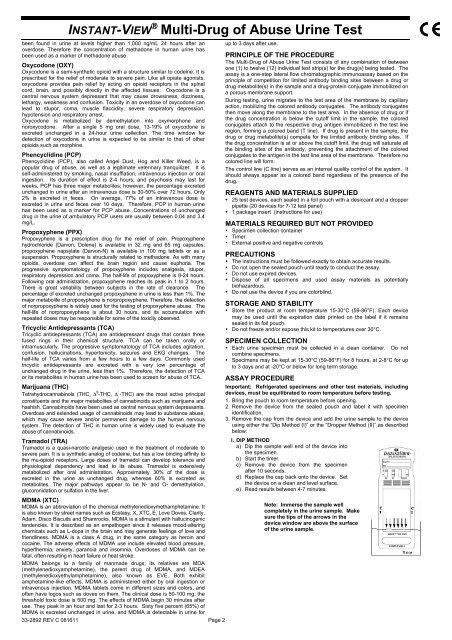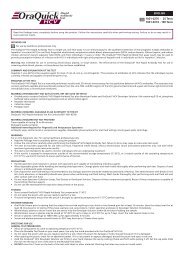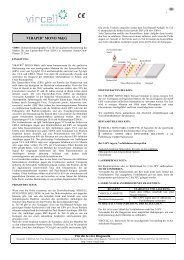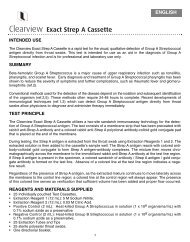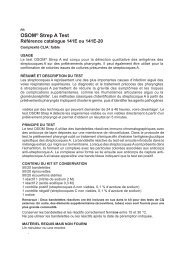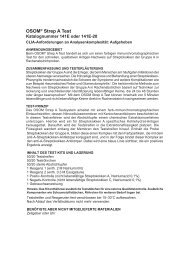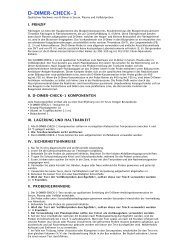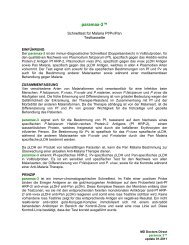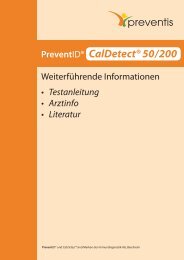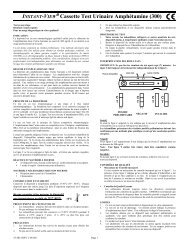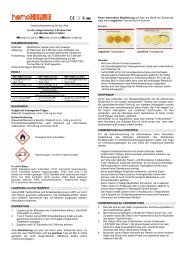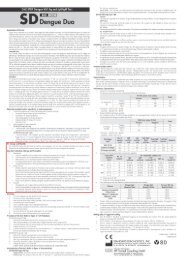INSTANT-VIEW® Multi-Drug of Abuse Urine Test - MD Doctors Direct
INSTANT-VIEW® Multi-Drug of Abuse Urine Test - MD Doctors Direct
INSTANT-VIEW® Multi-Drug of Abuse Urine Test - MD Doctors Direct
You also want an ePaper? Increase the reach of your titles
YUMPU automatically turns print PDFs into web optimized ePapers that Google loves.
<strong>INSTANT</strong>-VIEW ! <strong>Multi</strong>-<strong>Drug</strong> <strong>of</strong> <strong>Abuse</strong> <strong>Urine</strong> <strong>Test</strong><br />
been found in urine at levels higher than 1,000 ng/mL 24 hours after an<br />
overdose. Therefore the concentration <strong>of</strong> methadone in human urine has<br />
been used as a marker <strong>of</strong> methadone abuse.<br />
Oxycodone (OXY)<br />
Oxycodone is a semi-synthetic opioid with a structure similar to codeine. It is<br />
prescribed for the relief <strong>of</strong> moderate to severe pain. Like all opiate agonists,<br />
oxycodone provides pain relief by acting on opioid receptors in the spinal<br />
cord, brain, and possibly directly in the affected tissues. Oxycodone is a<br />
central nervous system depressant that may cause drowsiness, dizziness,<br />
lethargy, weakness and confusion. Toxicity in an overdose <strong>of</strong> oxycodone can<br />
lead to stupor, coma, muscle flaccidity, severe respiratory depression,<br />
hypotension and respiratory arrest.<br />
Oxycodone is metabolized by demethylation into oxymorphone and<br />
noroxycodone. After a single 5 mg oral dose, 13-19% <strong>of</strong> oxycodone is<br />
excreted unchanged in a 24-hour urine collection. The time window for<br />
detection <strong>of</strong> oxycodone in urine is expected to be similar to that <strong>of</strong> other<br />
opioids such as morphine.<br />
Phencyclidine (PCP)<br />
Phencyclidine (PCP), also called Angel Dust, Hog and Killer Weed, is a<br />
popular drug <strong>of</strong> abuse, as well as a legitimate veterinary tranquilizer. It is<br />
self-administered by smoking, nasal insufflation, intravenous injection or oral<br />
ingestion. Its duration <strong>of</strong> effect is 2-4 hours, and psychosis may last for<br />
weeks. PCP has three major metabolites; however, the percentage excreted<br />
unchanged in urine after an intravenous dose is 30-50% over 72 hours. Only<br />
2% is excreted in feces. On average, 77% <strong>of</strong> an intravenous dose is<br />
excreted in urine and feces over 10 days. Therefore, PCP in human urine<br />
has been used as a marker for PCP abuse. Concentrations <strong>of</strong> unchanged<br />
drug in the urine <strong>of</strong> ambulatory PCP users are usually between 0.04 and 3.4<br />
mg/L.<br />
Propoxyphene (PPX)<br />
Propoxyphene is a prescription drug for the relief <strong>of</strong> pain. Propoxyphene<br />
hydrochloride (Darvon, Dolene) is available in 32 mg and 65 mg capsules;<br />
propoxyphene napsylate (Darvon-N) is available in 100 mg tablets or as a<br />
suspension. Propoxyphene is structurally related to methadone. As with many<br />
opioids, overdose can affect the brain region and cause euphoria. The<br />
progressive symptomatology <strong>of</strong> propoxyphene includes analgesia, stupor,<br />
respiratory depression and coma. The half-life <strong>of</strong> propoxyphene is 8-24 hours.<br />
Following oral administration, propoxyphene reaches its peak in 1 to 2 hours.<br />
There is great variability between subjects in the rate <strong>of</strong> clearance. The<br />
percentage <strong>of</strong> excreted unchanged propoxyphene in urine is less than 1%. The<br />
major metabolite <strong>of</strong> propoxyphene is norpropoxyphene. Therefore, the detection<br />
<strong>of</strong> norpropoxyphene is widely used for the testing <strong>of</strong> propoxyphene abuse. The<br />
half-life <strong>of</strong> norpropoxyphene is about 30 hours, and its accumulation with<br />
repeated doses may be responsible for some <strong>of</strong> the toxicity observed.<br />
Tricyclic Antidepressants (TCA)<br />
Tricyclic antidepressants (TCA) are antidepressant drugs that contain three<br />
fused rings in their chemical structure. TCA can be taken orally or<br />
intramuscularly. The progressive symptomatology <strong>of</strong> TCA includes agitation,<br />
confusion, hallucinations, hypertonicity, seizures and EKG changes. The<br />
half-life <strong>of</strong> TCA varies from a few hours to a few days. Commonly used<br />
tricyclic antidepressants are excreted with a very low percentage <strong>of</strong><br />
unchanged drug in the urine, less than 1%. Therefore, the detection <strong>of</strong> TCA<br />
or its metabolites in human urine has been used to screen for abuse <strong>of</strong> TCA.<br />
Marijuana (THC)<br />
Tetrahydrocannabinols (THC, " 9 -THC, " 1 -THC) are the most active principal<br />
constituents and the major metabolites <strong>of</strong> cannabinoids such as marijuana and<br />
hashish. Cannabinoids have been used as central nervous system depressants.<br />
Overdose and extended usage <strong>of</strong> cannabinoids may lead to substance abuse,<br />
which may cause severe and/or permanent damage to the human nervous<br />
system. The detection <strong>of</strong> THC in human urine is widely used to evaluate the<br />
abuse <strong>of</strong> cannabinoids.<br />
Tramadol (TRA)<br />
Tramadol is a quasi-narcotic analgesic used in the treatment <strong>of</strong> moderate to<br />
severe pain. It is a synthetic analog <strong>of</strong> codeine, but has a low binding affinity to<br />
the mu-opioid receptors. Large doses <strong>of</strong> tramadol can develop tolerance and<br />
physiological dependency and lead to its abuse. Tramadol is extensively<br />
metabolized after oral administration. Approximately 30% <strong>of</strong> the dose is<br />
excreted in the urine as unchanged drug, whereas 60% is excreted as<br />
metabolites. The major pathways appear to be N- and O- demethylation,<br />
glucoronidation or sulfation in the liver.<br />
<strong>MD</strong>MA (XTC)<br />
<strong>MD</strong>MA is an abbreviation <strong>of</strong> the chemical methylenedioxymethamphetamine. It<br />
is also known by street names such as Ecstasy, X, XTC, E, Love Doves, Clarity,<br />
Adam, Disco Biscuits and Shamrocks. <strong>MD</strong>MA is a stimulant with hallucinogenic<br />
tendencies. It is described as an empathogen since it releases mood-altering<br />
chemicals such as L-dopa in the brain and may generate feelings <strong>of</strong> love and<br />
friendliness. <strong>MD</strong>MA is a class A drug, in the same category as heroin and<br />
cocaine. The adverse effects <strong>of</strong> <strong>MD</strong>MA use include elevated blood pressure,<br />
hyperthermia, anxiety, paranoia and insomnia. Overdoses <strong>of</strong> <strong>MD</strong>MA can be<br />
fatal, <strong>of</strong>ten resulting in heart failure or heat stroke.<br />
<strong>MD</strong>MA belongs to a family <strong>of</strong> manmade drugs; its relatives are <strong>MD</strong>A<br />
(methylenedioxyamphetamine), the parent drug <strong>of</strong> <strong>MD</strong>MA, and <strong>MD</strong>EA<br />
(methylenedioxyethylamphetamine), also known as EVE. Both exhibit<br />
amphetamine-like effects. <strong>MD</strong>MA is administered either by oral ingestion or<br />
intravenous injection. <strong>MD</strong>MA tablets come in different sizes and colors, and<br />
<strong>of</strong>ten have logos such as doves on them. The clinical dose is 50-100 mg; the<br />
threshold toxic dose is 500 mg. The effects <strong>of</strong> <strong>MD</strong>MA begin 30 minutes after<br />
use. They peak in an hour and last for 2-3 hours. Sixty five percent (65%) <strong>of</strong><br />
<strong>MD</strong>MA is excreted unchanged in urine, and <strong>MD</strong>MA is detectable in urine for<br />
33-2892 REV C 081611 Page 2<br />
up to 3 days after use.<br />
PRINCIPLE OF THE PROCEDURE<br />
The <strong>Multi</strong>-<strong>Drug</strong> <strong>of</strong> <strong>Abuse</strong> <strong>Urine</strong> <strong>Test</strong> consists <strong>of</strong> any combination <strong>of</strong> between<br />
one (1) to twelve (12) individual test strip(s) for the drug(s) being tested. The<br />
assay is a one-step lateral flow chromatographic immunoassay based on the<br />
principle <strong>of</strong> competition for limited antibody binding sites between a drug or<br />
drug metabolite(s) in the sample and a drug-protein conjugate immobilized on<br />
a porous membrane support.<br />
During testing, urine migrates to the test area <strong>of</strong> the membrane by capillary<br />
action, mobilizing the colored antibody conjugates. The antibody conjugates<br />
then move along the membrane to the test area. In the absence <strong>of</strong> drug or if<br />
the drug concentration is below the cut<strong>of</strong>f limit in the sample, the colored<br />
conjugates attach to the respective drug antigen immobilized in the test line<br />
region, forming a colored band (T line). If drug is present in the sample, the<br />
drug or drug metabolite(s) compete for the limited antibody binding sites. If<br />
the drug concentration is at or above the cut<strong>of</strong>f limit, the drug will saturate all<br />
the binding sites <strong>of</strong> the antibody, preventing the attachment <strong>of</strong> the colored<br />
conjugates to the antigen in the test line area <strong>of</strong> the membrane. Therefore no<br />
colored line will form.<br />
The control line (C line) serves as an internal quality control <strong>of</strong> the system. It<br />
should always appear as a colored band regardless <strong>of</strong> the presence <strong>of</strong> the<br />
drug.<br />
REAGENTS AND MATERIALS SUPPLIED<br />
• 25 test devices, each sealed in a foil pouch with a desiccant and a dropper<br />
pipette (20 devices for 7-12 test panel)<br />
• 1 package insert (instructions for use)<br />
MATERIALS REQUIRED BUT NOT PROVIDED<br />
• Specimen collection container<br />
• Timer<br />
• External positive and negative controls<br />
PRECAUTIONS<br />
• The instructions must be followed exactly to obtain accurate results.<br />
• Do not open the sealed pouch until ready to conduct the assay.<br />
• Do not use expired devices.<br />
• Dispose <strong>of</strong> all specimens and used assay materials as potentially<br />
biohazardous.<br />
• Do not use the device if you are colorblind.<br />
STORAGE AND STABILITY<br />
• Store the product at room temperature 15-30°C (59-86°F). Each device<br />
may be used until the expiration date printed on the label if it remains<br />
sealed in its foil pouch.<br />
• Do not freeze and/or expose this kit to temperatures over 30°C.<br />
SPECIMEN COLLECTION<br />
• Each urine specimen must be collected in a clean container. Do not<br />
combine specimens.<br />
• Specimens may be kept at 15-30°C (59-86°F) for 8 hours, at 2-8°C for up<br />
to 3 days and at -20°C or below for long term storage.<br />
ASSAY PROCEDURE<br />
Important: Refrigerated specimens and other test materials, including<br />
devices, must be equilibrated to room temperature before testing.<br />
1. Bring the pouch to room temperature before opening.<br />
2. Remove the device from the sealed pouch and label it with specimen<br />
identification.<br />
3. Remove the cap from the device and add the urine sample to the device<br />
using either the “Dip Method (I)” or the “Dropper Method (II)” as described<br />
below:<br />
I. DIP METHOD<br />
a) Dip the sample well end <strong>of</strong> the device into<br />
the specimen.<br />
b) Start the timer.<br />
c) Remove the device from the specimen<br />
after 10 seconds.<br />
d) Replace the cap back onto the device. Set<br />
the device on a clean and level surface.<br />
e) Read results between 4-7 minutes.<br />
Note: Immerse the sample well<br />
completely in the urine sample. Make<br />
sure the tips <strong>of</strong> the arrows in the<br />
device window are above the surface<br />
<strong>of</strong> the urine sample.


